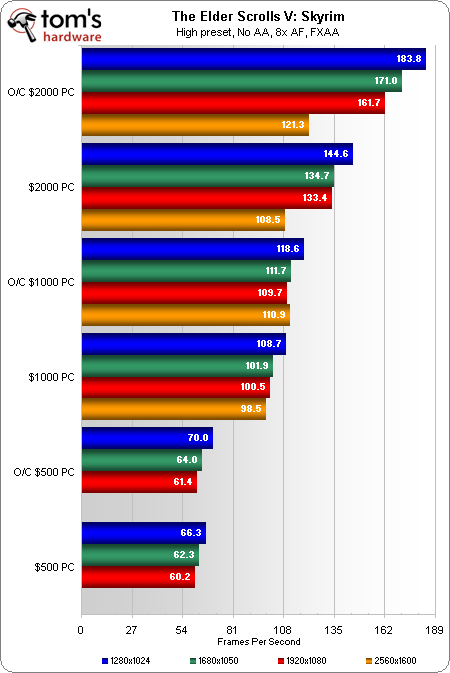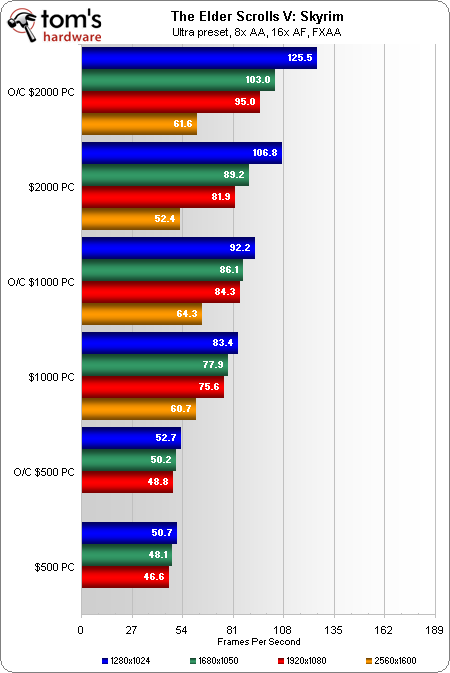System Builder Marathon, June 2012: System Value Compared
Deals
By
Thomas Soderstrom
published
Benchmark Results: The Elder Scrolls V: Skyrim
The $2000 PC begins our Skyirm-based benchmark set with a big lead at its lowest setting, only to watch as the $1000 build catches up and finally passes it at Ultra details and 2560x1600.
Even though the $500 PC is CPU-bottlenecked throughout the entire Skyrim benchmark set, it still manages to survive to its Ultra detail 1920x1080 target.
Current page: Benchmark Results: The Elder Scrolls V: Skyrim
Prev Page Benchmark Result: DiRT 3 Next Page Benchmark Results: StarCraft IIStay On the Cutting Edge: Get the Tom's Hardware Newsletter
Get Tom's Hardware's best news and in-depth reviews, straight to your inbox.
Thomas Soderstrom is a Senior Staff Editor at Tom's Hardware US. He tests and reviews cases, cooling, memory and motherboards.
58 Comments
Comment from the forums
-
Crashman mayankleoboy1toms, y u no include Quicksync benchies?Because it would be mean to the lower-cost PC builders? The truth is that the two applications that use it didn't appear all that popular with our readers.Reply -
mayankleoboy1 the only reason i see to buy a IB over a SB is better quicksync. Rest, they are same.Reply -
blazorthon mayankleoboy1the only reason i see to buy a IB over a SB is better quicksync. Rest, they are same.Reply
Replace the paste under the IHS on Ivy Bridge and those 3570Ks and 3770Ks overclock better than their Sandy counterparts. The IGP is also good for more than Quick-Sync. -
Crashman blazorthonReplace the paste under the IHS on Ivy Bridge and those 3570Ks and 3770Ks overclock better than their Sandy counterparts. The IGP is also good for more than Quick-Sync.And even with the stock IHS implementation, the power savings of Ivy at 1.25V looks good compared to Sandy at 1.35V (assuming both voltage levels get you to 4.6 GHz, which is approximately true).Reply -
blazorthon CrashmanAnd even with the stock IHS implementation, the power savings of Ivy at 1.25V looks good compared to Sandy at 1.35V (assuming both voltage levels get you to 4.6 GHz, which is approximately true).Reply
Yes, thanks. I forgot to mention the improved power efficiency from the new process node. -
jestersage As I indicated in the Gaming PC comments, I'm good with Paul's $500 experiment. But an Enthusiast PC at $1100? I figure you'll want to alter all those parts that got Don those un-edifying comments, then yeah! Bring it on!Reply
Aside from the 2500k, stick a GTX 670 in that thing I'll bet we'll have a real winner (depends on Tom's rules, I guess, since that part wasn't available at the time the SBM purchases were originally made).
Or step down to a 7870 and stick an SSD in it - for all those clamoring that a $1000 PC should have an SSD. -
blazorthon jestersageAs I indicated in the Gaming PC comments, I'm good with Paul's $500 experiment. But an Enthusiast PC at $1100? I figure you'll want to alter all those parts that got Don those un-edifying comments, then yeah! Bring it on! Aside from the 2500k, stick a GTX 670 in that thing I'll bet we'll have a real winner (depends on Tom's rules, I guess, since that part wasn't available at the time the SBM purchases were originally made). Or step down to a 7870 and stick an SSD in it - for all those clamoring that a $1000 PC should have an SSD.Reply
670 or 7970... Not much of a difference there. The two are effectively on-par with each other, trading blows depending on the game, resolution, and settings. Why not step down to a 7950, get a cheap SandForce SSD, and then up the CPU to the 2500K, all without even sacrificing graphics performance when overclocked? 7950s and 7970s that share a PCB and cooler have pretty much identical overclocking performance with the 7970s having an in-perceptively small advantage at the same frequency and the 7950 able to hit slightly higher frequencies.



